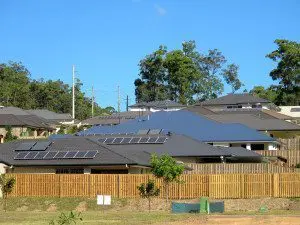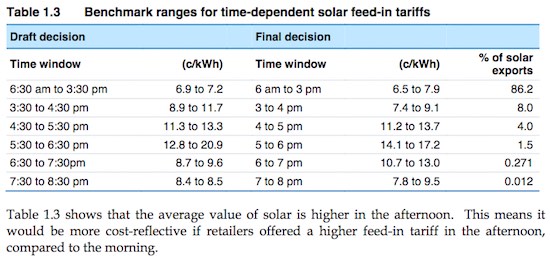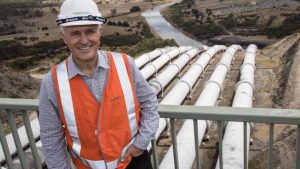New South Wales pricing regulator IPART has made good on plans to slash rooftop solar tariff almost by half, ignoring concerns the cut would penalise the state’s solar households for their role in helping to bring power prices down.
In a final decision published on Tuesday, IPART said it had set the state’s feed-in tariff benchmark at between 6.9-8.4c/kWh for the period of 2018/19, down from 11.9-15c/kWh.
The 44 per cent reduction in the price retailers are recommended to pay NSW solar households for their rooftop PV exports – it serves only to guide retailers, and is entirely voluntary – was first flagged by IPART in March.
And in an update published in May, IPART justified the proposed tariff cut by reasoning that wholesale electricity prices were forecast to fall in the coming financial year, partly because of the impact of rooftop solar, and so solar payments should, too.
This argument was reiterated by IPART on Tuesday, as it cut the price even further.
“We set the benchmark range based on our forecast of the average price that retailers would pay for solar exports across the day (weighted by solar output) if they were buying this electricity on the wholesale spot market,” IPART said.
“We consider that this is reasonable, and that a higher benchmark would lead to unacceptable outcomes.
“Specifically, if retailers were required to pay more than this for solar exports, they would be paying more than they pay for wholesale electricity on the NEM.
“As a result, retail prices for all customers would need to be higher to recover the difference,” it said.
How much? IPART says if the feed-in tariff was doubled , it could add around $19 a year to the bills of average households, or around 5c a day. But typically, it does not calculate the benefits that increased solar cold have on lowering prices.
And the regulator denies claims that cutting the tariff will effectively punish the state’s 10 per cent of solar households for the contribution they have made to shifting peaks, cutting network costs and reducing wholesale power prices for all consumers.
In fact IPART disagrees with that notion, instead taking the line that solar exports are not likely to provide system-wide net benefits for networks, and in some cases – on some parts of the grid – were more likely to do the opposite.
“Solar panels do have the potential to create network benefits by deferring network expenditure where it reduces demand on the network at peak times, but this is likely to be the case only in limited parts of the network,” the July report said.
“In many parts of the network, solar exports are unlikely to contribute to meeting peak demand on the distribution and transmission networks because the peak occurs in the late afternoon when the proportion of exports is very low.
“In these areas, solar exports are unlikely to defer network costs. In other areas, large volumes of solar exports are driving higher network costs due to additional investment required to support the bi-directional flows of electricity to handle the volume of solar exports,” IPART said.
“In summary, the benefits of solar depend on the particular location in the network, and as a result recent reviews by the AEMC and the Victorian Essential Services Commission (ESC) both concluded that potential network benefits are too variable between location, across times, and between years to be well suited for remuneration via a broad-based tariff.
“We consider that solar customers should be treated like any other generator in the competitive electricity market, which means that they take or pay the market price – and are not otherwise compensated or penalised for their impact on these prices,” the report said.
As we noted in May, this seems to fly in the face of a move by Ausgrid to encourage more rooftop solar in its network so that it can deflect network upgrades.
IPART’s line also stands it apart from its counterpart in Victoria, which was asked to include both a social price of carbon in its tariffs.
Green groups and solar advocates have reacted angrily to the decision, describing it as “daylight robbery” a big step in the wrong direction.
“The decision to cut the feed-in tariff punishes solar owners, it’s like getting a pay cut for working overtime,” said Solar Citizens senior campaigner Shani Tager in emailed comments on Tuesday.
Tager cites research commissioned by Solar Citizens that shows NSW solar households cut at least $2.2 billion off the wholesale price of power for everybody in the state in just one year.
“Solar owners have been doing the heavy lifting, keeping the lights on in NSW during heatwaves and cutting power prices for everybody, it’s time that the many benefits of rooftop solar are recognised,” she said.
“Letting big energy retailers off the hook and allowing them to make a profit from the hard work of solar owners is daylight robbery that won’t end until the government steps in.
“The buck stops with the NSW government, they should use their power to intervene and set a fair price for solar that takes into account the wholesale price of power as well as the social and environmental benefits of rooftop solar.
“Slashing the feed-in tariff sends absolutely the wrong message to households in NSW who would like to go solar,” said Tager.
The NSW Greens also pointed the finger at the state government, describing the tariff cut as is a direct result of the its failure to instruct IPART to assess the true value of solar power.
They say the tariff cut is a major step in the wrong direction, particularly for a state that – as we reported here – relies on coal generation more than any other grid in the world, and has also been Australia’s biggest net importer of electricity, a new report has found.
“If the NSW government are serious about supporting renewable energy then they should be change the criteria to assess solar feed-in tariffs to recognise the multitude of benefits solar energy brings,” Greens MP Tamara Smith said on Tuesday.
“NSW should be ensuring that electricity retailers pay a fair price for the solar electricity that is fed into the grid from roof top systems, which takes into account the avoided health and carbon costs solar brings by reducing the amount of fossil fuels that are burnt.
“Unless the NSW government steps in then this decision will be a huge hit to the electricity bills of over 400,000 households and businesses that have installed solar panels in NSW and will act as a disincentive to further uptake of solar panels.
“Solar power is working to even out demand peaks and reduce electricity prices. Households and businesses should be rewarded for this service, not penalised for the benefit of big coal.
“The Greens recognise that solar power leads to cleaner air, reduced carbon emissions and cheaper electricity. The uptake of solar power should be encouraged and that is why the Greens have introduced a Bill into the NSW Parliament to ensure a minimum, fair price for solar.”
Where the state government did exercise its influence was in the introduction of time-dependent solar feed-in tariff benchmark ranges, which was also confirmed by IPART on Tuesday (see table below).
This “specifically requested” change, the report explains, means retailers “could choose to offer a tariff that varies depending on the time of day the solar customer exports to the grid.”
And while IPART argues there is little measurable value of solar to the grid, these time-dependent price ranges serve to place a value on battery storage – or stored solar power.
“Even though solar exports are very low after 5pm, we set benchmarks in the later afternoon and evening because wholesale prices are highest at this time,” IPART said.
“Currently, customers have a limited ability to respond to a high feed-in tariff in the very late afternoon because there is limited sunlight at this time. However, these benchmarks provide a price signal to customers with batteries, or considering purchasing batteries, about when they should export their energy to the grid.
“Only around 1,600 households in NSW currently have batteries, representing less than 0.1 per cent of households. But over time this signal will become more important as battery prices fall and their uptake increases,” the report says.
This article was originally published on RenewEconomy’s sister site, One Step Off The Grid, which focuses on customer experience with distributed generation. To sign up to One Step’s free weekly newsletter, please click here.









